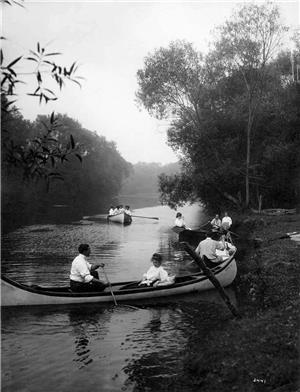Homer Venishnick, born in Renton, Washington in 1926, comes from a long line of fishermen whose livelihoods have hinged on the ebb and flow of local rivers. Today he lives in a house he built 50 years ago. "I started it, dug the hole, 50 years in April this year. Cost me $24 dollars to dig the hole. I'm still working on it."
Homer's house overlooks Lake Washington, downtown Renton, and Boeing's lakeside plant. This view sets the stage for a 100 year history of King County's rivers, touching on subjects as varied as Seattle and Renton's urban development, salmon runs, water management, the timbering industry and pole-jumping. This account is one of several People's Histories based on a January 17, 2000 HistoryLink interview.
One Big Fish
Homer holds a dog-eared black and white photograph taken in the summer of 1940 that verifies one of his favorite fish stories. In it, he stands with his good friend Jim Duncan, holding a sixty-four pound King salmon that overwhelms a 36" yardstick. "We caught it on the Cedar. I was about 13 or 14. There were bigger fish in the river than that." Decades later he made a wooden fish the same size, which he uses to explain the scale of this enormous catch. The much-handled photograph documents what a lot of people today can't believe. "You know," he told me, "I was involved with the Cedar River Naturalists, and they told me I was a liar. 'You can't catch fish like that,' they said."
Still fishing sixty years later, he shows me a color photograph of salmon caught in October of 1997 in the Queets River on the Olympic Peninsula. "I should have straightened out the tail so you can see how long it is. It was 55 pounds."
Over the decades, Homer has come to think carefully about the many forces affecting salmon runs, salmon size, and diminishing species. The difference between the management of the Cedar and the Queets has made all the difference. "The Queets is part of a National Park, the Olympic National Park, all except for seven miles which are an Indian reservation so if a stream is messed with, they can still reproduce. That's my theory. Indians put their nets in there and they still got through and survived. And the river has even moved back and forth. It'll move a quarter of a mile, half a mile in that basin."
Moving the River
The size of the fish caught in the Cedar is directly related to the amount of water flowing through it. "There was a lot more water in the Cedar years ago. I mean you can't conceive how much water there was, even in the dry seasons ... ever heard of the Molassas Creek 5000?" Homer describes the water management system that was put into place in the 1940s, which kept "the flow moving ... it takes a long time to get it going again. They just dumped (the recycled water) back into the Cedar River."
"They were probably dumping almost as much in the Cedar River as there is in the river now in summer time. They were dumping for years and years. Then they put the pipeline up to Bellevue, out at 32nd. It's feeding Bellevue, and Newport Shores and Lake Hills and Kirkland, into a tremendous aquifer running under the airport, up to White Center (a West Seattle neighborhood)."
"There's probably a dozen different water districts over there, and without Seattle charging that aquifer those folks would be out of water. In fact, the whole lake never used to go up and down until you got housing over there (West Seattle). With the water they take out, the lake changes four of five feet a year. So the aquifer has changed too.
Troubled Waters
Homer speculates, "if you took all the water out of Cedar River ... has Lake Washington got a chance, you know? Cause you don't have the flow-through. I hate to say it, but I'd be surprised if you'd see any Kings in fifty years. You might see some Sockeyes, but I don't think you'd see any Kings. Its just not worth it anymore, there's not enough water."
"It's really sad when you see a big King go up the river on its side because there's not enough water in the river. That's hard on a fish, he's at the end of his life cycle. He's come to do what he's been put on this earth for, to reproduce."
Many local residents are concerned about fate of the Cedar River and salmon runs -- Homer Venishnick has taken his historical perspective into schools, scout troops, and other community organizations, hoping to raise awareness of environmental issues as they relate to river history.

